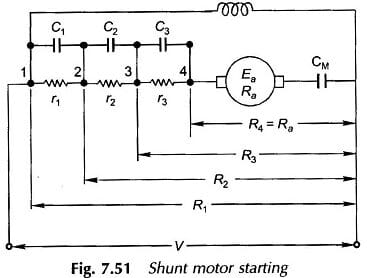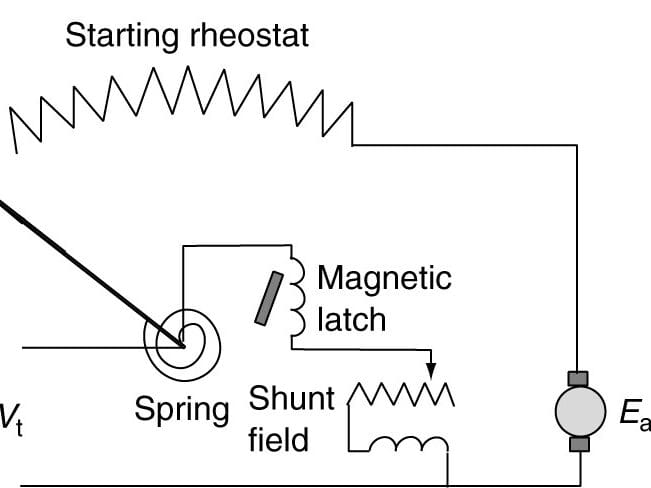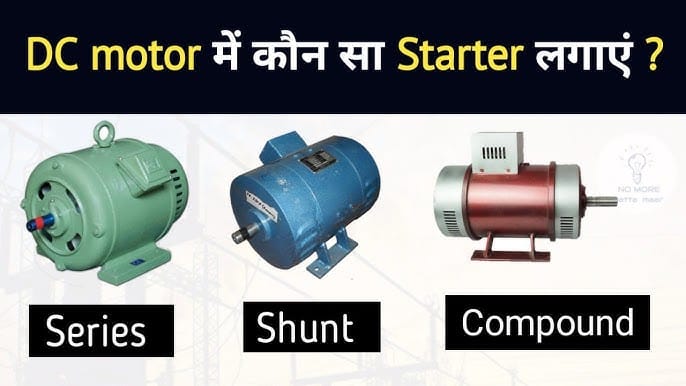Table of Contents
DC Motor Starter:
DC motors, especially those below 1 HP (0.746 kW), can often be directly connected to a power supply. This is possible because smaller motors have a relatively high armature resistance (Ra), which naturally limits the starting current. Some examples include:
- Universal motors are used in kitchen mixers and grinders
- Small portable drilling machines
- Tiny DC motors (below 24V) used in toys
However, this direct online starting method cannot be used with larger motors
Direct Connection in Small DC Motors
For DC motors with a rating below 1 HP (0.746 kW), it is common to connect them directly to the power supply. This is due to their relatively high armature resistance (Ra), which naturally limits the initial inrush of current.
Universal Motors in Household Appliances
Small series motors used in devices like kitchen mixers, grinders, and portable drills are often designed as universal motors. These can operate on both AC and DC supplies and have built-in design features that prevent excessive starting current.
Toy Motors and Low-Voltage Units
Miniature motors under 24V rating, such as those used in toys, are also safe for direct connection. Their size and limited load requirements ensure that even without a starter, the initial current does not pose a threat.
Challenges in Starting Larger DC Motors
As motor size increases, so does the risk during startup. Moderate and large-capacity DC motors are not safe to start by direct connection due to:
- Low armature and series field resistance (Ra and Rse), designed for efficiency.
- No back electromotive force (Eb) when the rotor is stationary.
- Dangerously high transient currents, which can exceed 10x the rated current.
Why Larger Motors Need a Starter
For bigger motors, directly connecting to the power supply is not safe. Why?
- They have very low armature resistance.
- This causes a huge inrush of current at the moment of starting.
Such high currents can damage the motor windings and reduce motor life. That’s why we use starters like:
- Two-point DC Motor Starter for series motors
- Three-point or four-point DC Motor Starter for shunt motors
Voltage Equation of DC Motors
The back EMF (Electromotive Force) is key to motor behavior at start and while running. The equations are:
For DC shunt and separately excited motors:
V = Eb + IaRa
For DC series and compound motors:
V = Eb + Ia(Ra + Rse)
Where:
- V = Supply voltage
- Eb = Back EMF
- Ia = Armature current
- Ra = Armature resistance
- Rse = Series field resistance
Back EMF and Speed Relationship
At the moment of starting:
- The motor is at rest (N = 0), so Eb = 0.
- So the entire voltage appears across the armature:
Ia = V / Ra
which can be very large for big motors.
Once the motor starts running:
- It generates back EMF (Eb).
- This opposes the supply voltage, thereby reducing the armature current.
Back EMF Equation:
Eb = (P ∗ Φ ∗ Z ∗ N) / (60 ∗ A)
Which is often written as:
Eb = k ∗ Φ ∗ N
Where:
- P = Number of poles
- Φ = Flux per pole
- Z = Total armature conductors
- N = Speed in RPM
- A = Number of parallel paths
- k = Constant depending on motor construction
So, the speed N is directly proportional to back EMF and inversely proportional to flux (Φ).
Starting of DC Motors:
When a DC supply is connected to a motor, and the rotor has not yet started turning, the motor is said to be in the starting condition. At this point, the rotor speed, which means the back electromotive force (Eb), is also zero.

According to the voltage equations of DC motors:
- For DC shunt and separately excited motors:
- For DC series and compound motors:
Since during start, the equations become:
- for shunt motors
- for series/compound motors
This means the starting current (Ia) is limited only by the resistance of the windings.
In small DC motors (below 1 HP), the armature resistance is relatively high. So, even if connected directly to the supply, the current remains within safe limits. That’s why direct starting is acceptable in:
- Tiny motors used in toys
- Universal motors (like those in kitchen mixers, grinders, portable drills)
However, for larger motors, the resistances and are kept low to improve efficiency by reducing copper losses. So, applying full voltage directly at startup can lead to dangerously high inrush current, known as starting current.
This sudden high current can damage the windings, commutator, and brushes, or even trip protection devices. Hence, external resistors or starters are used in moderate and large motors to safely limit the current during startup.
In summary:
- At starting, speed = 0 → back EMF = 0
- Armature current depends only on internal resistances
- In large motors, low resistance leads to high starting current
- Hence, starters are necessary to protect the motor during startup
Example: The Need for a Starter in a DC Motor
Let’s take a practical example to understand why a starter is crucial for DC motors.
Consider an 8.8 kW (11.8 hp), 220V DC shunt motor with an armature resistance (Ra) of 0.5 Ω.
Step 1: Calculate the Rated Armature Current
The rated current is the highest current the motor can safely handle:
Rated armature current (Ia) = Power / Voltage = 8800 W / 220 V = 40 A
Step 2: Starting Condition (Back EMF = 0)
When the motor is first switched on, the back EMF (Eb) is zero, so the entire voltage appears across the armature.
Using Ohm’s Law:
Starting current (Ia) = V / Ra = 220 V / 0.5 Ω = 440 A
This current is 11 times higher than the rated current and can be highly damaging.
What Can Go Wrong with Such High Starting Current?
- Excessively large starting torque
- This can damage the coupling between the motor and the load shaft.
- Heavy sparking at the commutator and brushes
- It can lead to serious damage and shorten the lifespan of these components.
- Formation of hot spots in the windings
- These may weaken the insulation and lead to winding failure.
- Blown fuses
- The sudden high current can trip protective devices.
- Damage to the rectifier
- If the motor is powered by an AC to DC converter, this surge may harm the converter.
- Voltage drop in supply lines
- This affects other electrical equipment connected to the same power source.
Why Do We Need Different Types of DC Motor Starters?
Now that we know a DC motor needs a gentle push to start, let’s talk about how we give that push through different types of starters.
Once the motor’s rotor starts turning, something magical happens: it begins to generate a kind of “invisible push” called back EMF. This back EMF pushes against the flow of electricity and helps bring the current down to a safe level. But during those first few moments, the motor is vulnerable. If we don’t handle it properly, the motor could burn its wires, spark, or even break its own parts.
So what do we do?
We use a starter—a special device designed to control the starting current and protect the motor from both electrical and mechanical harm.
Manual vs. Automatic Starters: What’s the Difference?
Think of it like riding a bicycle. You can either pedal manually or you can use a motorized assist. Starters work in a similar way:
- Manual Starters need a person to operate them. You turn a knob or pull a lever to control the starting current.
- Automatic Starters do the job by themselves, using sensors and circuits to decide when to reduce resistance and let the motor run freely.
Let’s look at a few manual DC Motor starters you might come across.
Types of Manual DC Motor Starter
🔹 For DC Shunt Motors:

- 3-Point DC Motor Starter
This is a simple and widely used type. It has three connections: one to the supply, one to the armature, and one to the field coil. It controls the current and also protects the motor if the voltage suddenly drops. - 4-Point DC Motor Starter
A more improved version. It gives better control and extra protection. Even if the motor speed changes or the voltage fluctuates, the 4-point starter maintains system stability.\

🔹 For DC Series Motors:
- 2-Point DC Motor Starter (No-Load Release Starter)
This is specially designed for series motors. It has two main points: one for the power and one for the armature. It protects the motor from running without a load (which could make it overspeed and get damaged). That’s why it’s also called a no-load release starter. - No-Volt Release DC Motor Starter
This type makes sure the motor stops if the power supply is accidentally cut. It won’t allow the motor to restart suddenly without proper handling, which is a big safety advantage.
What Do Starters Do?
You might be wondering—what’s happening inside these devices?
It’s quite simple: Starters add extra resistance in the beginning, like a traffic cop telling cars to slow down. As the motor speeds up and becomes safe to handle full power, the starter removes that resistance step by step.
Most manual DC Motor starters also come with safety features:
- No-Volt Release: Automatically turns off the motor if power drops.
- Overload Protection: Shuts the motor down if it starts drawing too much current.
So in a way, a starter is like a guardian angel for your DC motor—it doesn’t just help it start, but also protects it while it runs.
Conclusion
This example clearly shows why a DC Motor Starter is essential in DC motors. By limiting the initial current, a starter protects the motor, the power system, and connected components from damage.
FAQ
What is a DC Motor Starter and Why is it Needed?
A DC motor starter is a device used to safely start and stop a DC motor. At startup, a motor draws a very high current because the back EMF (electromotive force) is initially zero. This high current can damage the motor windings. A starter limits this inrush current and ensures smooth acceleration.What Are the Main Types of DC Motor Starters?
Commonly used DC motor starters include:
Two-Point Starter – Used with DC shunt motors.
Three-Point Starter – Also used with DC shunt motors and includes a no-voltage release coil.
Four-Point Starter – An improved version of the three-point starter with separate excitation control.
Starter for Series Motor – Specifically designed for series-wound motors.What is the Difference Between a 3-Point and 4-Point Starter?
The primary difference lies in how the no-voltage coil is connected:
In a three-point starter, the no-voltage coil is in series with the field winding. If the field current changes, the starter may trip unexpectedly.
In a four-point starter, the no-voltage coil is connected directly across the supply, making it independent of the field circuit. This provides greater stability and reliability.How Does a DC Motor Starter Work?
A starter works by inserting external resistance in series with the armature during startup. As the motor speeds up, back EMF develops, reducing the current. The added resistance is gradually cut out, either manually or automatically. Most starters also include over-current and no-voltage protection.
What is Back EMF in a DC Motor?
Back EMF is the voltage generated by the rotating armature of the motor. It opposes the applied voltage and increases with motor speed. Back EMF plays a key role in controlling the current flow and ensuring efficient operation.
